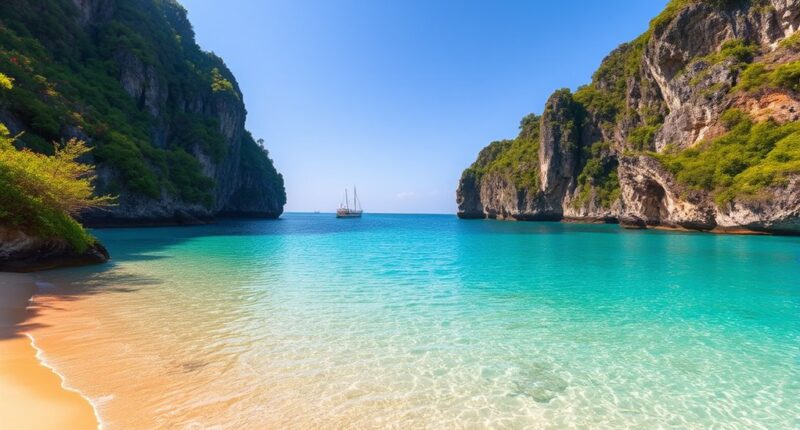In 2026, consider exploring lesser-known destinations like Paraguay, with its colonial towns, vibrant festivals, and eco-friendly initiatives. Oman offers desert landscapes, ancient forts, and sustainable wilderness experiences. Northern Italy, especially around the 2026 Winter Olympics, combines culture, sport, and luxury in regions like the Dolomites. Southeast Asia’s festivals, such as Indonesia’s Komodo Dragon Festival and Sri Lanka’s Kandy Esala Perahera, showcase authentic traditions and ecological awareness. Discover these off-the-radar spots for unforgettable adventures ahead.
Key Takeaways
- Paraguay’s colonial towns and national parks offer rich heritage and eco-tourism with increasing accessibility in 2026.
- Oman’s desert landscapes, ancient forts, and eco-lodges provide authentic, sustainable adventures in a less-traveled setting.
- Italian regions like the Dolomites and Costa Smeralda gain popularity through the 2026 Winter Olympics and cultural immersion.
- Southeast Asia’s festivals, such as Indonesia’s Komodo Dragon Festival and Sri Lanka’s Kandy Esala Perahera, highlight ecological and cultural experiences.
- Stylish, functional accommodations incorporating eco-friendly decor enhance immersive, responsible travel experiences worldwide.

As travelers seek new and authentic experiences in 2026, emerging destinations around the world are capturing attention beyond traditional hotspots. This year, off-the-radar places like Paraguay, Oman, and lesser-known regions in Italy and Southeast Asia beckon for their rich culture and untouched landscapes. Paraguay, for instance, offers a blend of small colonial towns, lush national parks, and a vibrant Indigenous and Spanish heritage. It remains relatively underexplored, but increased access and interest are expected to elevate its profile in 2026. Visiting between May and September allows you to enjoy favorable weather while immersing yourself in local traditions. Paraguay’s cultural festivals provide a window into its heritage, with local celebrations showcasing indigenous music, dance, and crafts. Additionally, eco tourism initiatives are gaining momentum here, emphasizing sustainable travel that preserves the environment and supports local communities. Travel infrastructure is improving, making it easier for visitors to explore remote areas comfortably and sustainably.
In Oman, you’ll find a unique mix of desert mountains, turquoise coastlines, and ancient forts that highlight old-world charm. The country is poised to become more popular as eco-friendly travel options expand, including eco-lodges and wilderness experiences. The best time to visit is from October to April when outdoor activities like luxury wild camping, snorkeling, and canyon exploration become more accessible. Oman’s focus on eco tourism initiatives makes it a prime destination for sustainable adventurers. Its rugged landscapes and authentic cultural sites promise an off-the-beaten-path experience that’s both enriching and responsible. Meanwhile, in Italy’s emerging regions like the Dolomites and Costa Smeralda, travelers are seeking design-led stays and culturally immersive adventures. With the 2026 Winter Olympics in Milan, Northern Italy is gaining even more attention, blending sport, luxury, and local culture.
Southeast Asia also offers compelling options. Indonesia’s lesser-visited islands like Flores host the Komodo Dragon Festival, a vibrant celebration that combines cultural tradition with ecological awareness. Sri Lanka’s compact size makes it easy to explore beaches, rainforests, and ancient ruins in one trip, with the Kandy Esala Perahera festival highlighting its rich cultural tapestry. The Philippines continues to intrigue travelers, though specific emerging trends are still developing. These destinations emphasize slow travel and local engagement, supporting eco tourism initiatives and helping visitors connect authentically with the environment and communities. Additionally, the use of wall organization systems and aesthetic decor elements in accommodations can enhance the overall experience, making travel stays more stylish and functional.
Frequently Asked Questions
How Are These Destinations Expected to Develop Tourism Infrastructure by 2026?
By 2026, you’ll see these destinations develop tourism infrastructure through major transportation improvements like new airports and expanded regional flight networks, making access easier. Local hospitality will also get a boost, with upgraded hotels and luxury resorts that cater to diverse travelers. These enhancements will create seamless travel experiences, promote sustainable tourism, and support community growth, ultimately attracting more visitors enthusiastic to explore off-the-radar places.
What Are the Safety Considerations for Travelers Visiting These Emerging Spots?
When visiting emerging destinations, you should prioritize safety by being aware of security risks and taking health precautions. Stay informed about local crime trends and government advisories, and consider traveling with reputable operators. Protect yourself by understanding local laws, avoiding risky areas, and carrying necessary medical supplies. Respect local customs to prevent misunderstandings, and always remain vigilant of your surroundings to guarantee a safe and enjoyable trip.
Are There Any Cultural Sensitivities to Be Aware of in These Locations?
You should be aware of local customs and dress codes to avoid offending residents. Respect traditional practices, especially during festivals or visits to sacred sites, by dressing modestly and following local etiquette. Engage with community members, participate in cultural events, and learn about taboos beforehand. This approach shows respect, enriches your experience, and helps you connect authentically with the culture while traveling in these emerging destinations.
What Sustainable Travel Practices Are Recommended for These Off-The-Radar Places?
Did you know that eco-friendly accommodations often use 30% less energy? To practice sustainable travel in off-the-radar places, choose eco-friendly accommodations that prioritize renewable energy and waste reduction. Support responsible wildlife tourism by observing animals from a distance and avoiding activities that harm ecosystems. Engage with local communities, purchase local goods, and participate in conservation efforts to minimize your environmental impact and help preserve these unique destinations for future visitors.
How Can Travelers Support Local Communities Responsibly in These Destinations?
You can support local communities responsibly by engaging in community-led activities and practicing ethical tourism. Hire local guides, participate in community tours, and choose homestays or community-run lodges that reinvest in the area. Buying from local artisans and supporting conservation efforts also makes a difference. Your respectful attitude, cultural sensitivity, and willingness to learn help foster genuine community engagement, ensuring your travel benefits the local people and preserves their heritage.
Conclusion
As you explore these hidden gems, keep in mind they’re quietly gaining recognition, offering a gentle escape from the well-trodden paths. Embrace the opportunity to discover something uniquely charming before it becomes the next big thing. With each visit, you’ll help shape these places’ stories, adding your own chapter to their unfolding adventure. So, stay curious and open-minded—these off-the-radar destinations await your gentle touch to help them flourish.









